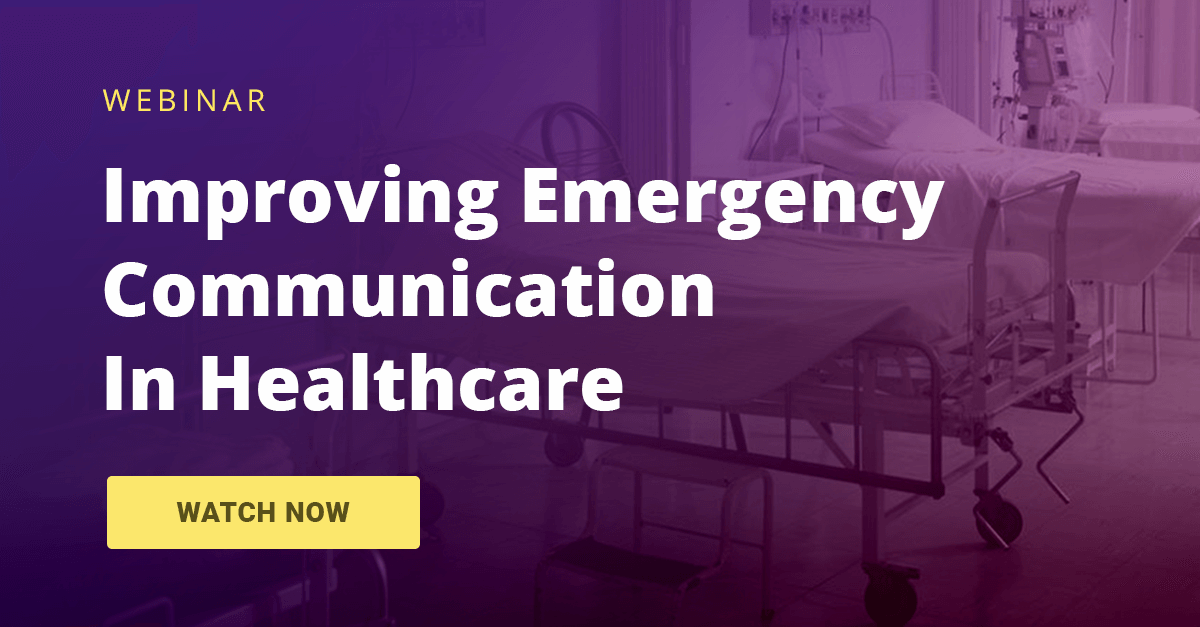Emergency Notification Systems For Healthcare Organizations: Emergency Alerting Tips
As part of the new CMS Emergency Preparedness Rule, healthcare organizations need to be able to communicate with their personnel during an emergency. As part of their overall plan, many providers use an emergency notification system.
But just having an ENS isn’t enough. With a little time and some planning, healthcare organizations can improve their preparedness by creating prewritten alerts and using their ENS to target their communications to specific roles within their organization.
Why Is Communication So Important To The Emergency Preparedness Process?
Communication is one of the four pillars (along with assessing threats, setting policies and procedures and implementing training and exercises) of the CMS Emergency Preparedness Rule.
Communication is at the heart of emergency response - both to alert personnel of potential threats as well as to collect vital information that will help first responders and law enforcement respond more effectively.
The concern of many emergency preparedness experts is that healthcare organizations may not be communicating as effectively as they could be. With some guidance and lessons learned from other providers, healthcare organizations can implement new best practices.
Communication Is Top Challenge For Healthcare Providers
Meg Nash, MPH, said emergency communications is the biggest hurdle for healthcare organizations.
“Communication is the part where a lot of people are left scratching their heads, unsure of where to begin or what the best plan is," Nash said during a recent AlertFind webinar.
Indeed, she added, communication is cited as the biggest failure in 80% of all training after-action reports.
“Management often fall back on the idea ‘Emergency communication is the same as regular daily communication,’ ” she said. “And it's not, which makes for bigger challenges.”
Tips For Successful Alerting
Issues often arise when there are gaps in the alerting structure; or if a protocol was established, but doesn’t function properly or efficiently. Nash recommended three methods for providing efficient healthcare alerting.
- Communication needs to be targeted to specific departments. Unlike other organizations, healthcare providers have a life-saving function and can’t easily shut down an entire hospital. Instead they may need to just shut down a department while other areas continue to operate.This is where geofencing comes in. By drawing a circle around a specific location within your ENS, you can notify everyone in that area - regardless of role. Nash is a strong proponent of geofencing because they can be set up with triggers by administrators – so that when a device enters or exits an area, it will receive all relevant alerts.
- Two-way communication allows recipients to reply with relevant information. “Two-way communications are essential in rapidly-evolving situations or where there’s poor situational awareness creating a high degree of risk to patients, staff or facility,” Nash said. “It definitely allows for more on-the-spot decision making so that when we’re making our plans we don’t necessarily need to envision every eventuality and every possible modification to it.”
- Role-based alerting allows organizations to send messages to certain positions to communicate important information. Role-based alerts are vital to the safety of doctors, staff and patients as well. For example, it is unlikely that the surgical team would use a mobile phone during a surgery.
However, you can design your communications plan so that the scrub nurse will be alerted and will then either step outside the operating room to get more information or will relay the information they received at the least disruptive time.
As part of the training, you can discuss how they can respond and what options they have for the different situations they may find themselves in - preparing for the surgery, an active operation or post-surgery.
Best Practices For Writing Alerts
The alerts themselves also need to be structured clearly and cover three key areas: Who is sending the alert, what the emergency is and what protective action you want them to take.
“Keep it short and direct. It’s got to be reinforced and it has to be on multiple channels,” she said.
All alerts should also be sent out over multiple channels - texts, emails, public announcements, pages and calls - to increase the chances the recipient will see it immediately and be able to take protective action.
“Your alerts need to be actionable,” Nash said. “Any miscommunication you have during an event can have huge, negative effects.”
Looking for more ideas about how to build an emergency communication plan? Download AlertFind’s eBook, “10 Actions Healthcare Organizations Can Take To Improve Their Emergency Preparedness And Communications.”
Nash provided much deeper guidance for healthcare organizations on how to comply with the CMS Emergency Preparedness Rule during AlertFind’s recent webinar, “Improving Emergency Communications Under The Emergency Preparedness Rule: Are You Ready?”

You are well on your way toward protecting your staff and organization.
Take the next step toward protecting your organization by learning more about emergency notification systems and the vital role they play in your emergency preparedness plan.
